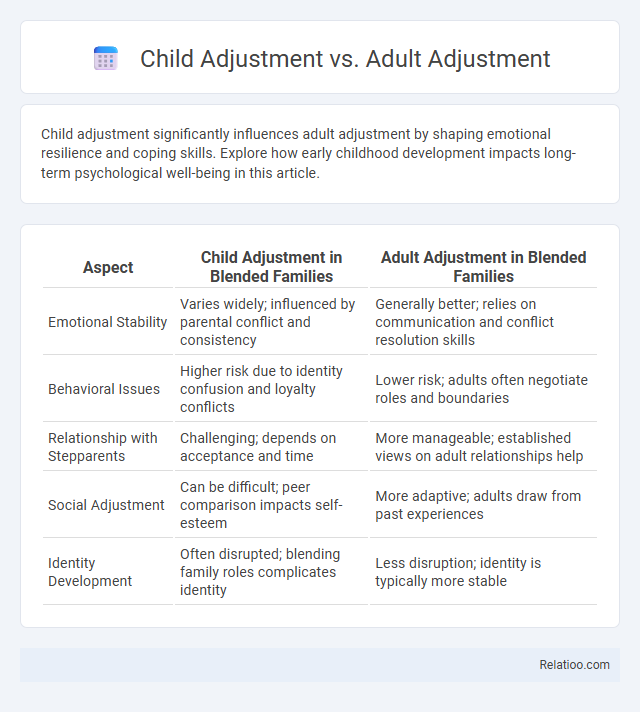Child adjustment significantly influences adult adjustment by shaping emotional resilience and coping skills. Explore how early childhood development impacts long-term psychological well-being in this article.
Table of Comparison
| Aspect | Child Adjustment in Blended Families | Adult Adjustment in Blended Families |
|---|---|---|
| Emotional Stability | Varies widely; influenced by parental conflict and consistency | Generally better; relies on communication and conflict resolution skills |
| Behavioral Issues | Higher risk due to identity confusion and loyalty conflicts | Lower risk; adults often negotiate roles and boundaries |
| Relationship with Stepparents | Challenging; depends on acceptance and time | More manageable; established views on adult relationships help |
| Social Adjustment | Can be difficult; peer comparison impacts self-esteem | More adaptive; adults draw from past experiences |
| Identity Development | Often disrupted; blending family roles complicates identity | Less disruption; identity is typically more stable |
Understanding Child Adjustment: Key Concepts
Understanding child adjustment involves recognizing how children adapt emotionally, socially, and behaviorally to their environments, which differs significantly from adult adjustment that often relies on more developed cognitive and coping skills. Emotional adjustment in children focuses on their ability to manage feelings like anxiety, frustration, and sadness in response to family dynamics, school challenges, or peer relationships. Key concepts include resilience, attachment security, and emotional regulation, which are foundational in promoting healthy development and long-term psychological well-being.
Defining Adult Adjustment: Core Elements
Adult adjustment involves managing life changes by developing emotional resilience, effective coping strategies, and maintaining stable relationships. Core elements include psychological flexibility, self-regulation, and the ability to balance personal and professional responsibilities. Your capacity to adapt emotionally and behaviorally to new challenges defines successful adult adjustment.
Developmental Stages Impacting Adjustment
Child adjustment involves developing foundational emotional and social skills critical for later life success, while adult adjustment requires managing complex responsibilities and relationships shaped by past experiences. Emotional adjustment fluctuates across developmental stages, reflecting evolving cognitive capacities and coping mechanisms from childhood to adulthood. Your ability to adapt emotionally depends heavily on how well previous stages of adjustment have been navigated, influencing overall mental resilience and well-being.
Emotional Regulation: Children vs Adults
Emotional regulation in children involves developing foundational skills to identify, express, and control emotions, often supported by caregivers and guided experiences. Adults typically employ more advanced strategies, such as cognitive reappraisal and stress management techniques, reflecting matured neural pathways in the prefrontal cortex. Differences in emotional regulation impact overall adjustment, with children relying on external support and adults utilizing learned coping mechanisms to maintain psychological well-being.
Social Adaptation Across Ages
Social adaptation varies significantly across life stages, with child adjustment focusing on developing fundamental interpersonal skills and peer relationships essential for school and family environments. Adult adjustment centers on managing complex social roles, work dynamics, and maintaining long-term relationships. Your ability to achieve emotional adjustment influences successful social adaptation, enhancing resilience and communication throughout childhood and adulthood.
Coping Strategies: Childhood and Adulthood
Child adjustment relies heavily on play therapy, parental support, and developing basic emotional regulation skills to cope with stress and transitions, while adult adjustment emphasizes cognitive reframing, problem-solving techniques, and social support networks to manage complex life challenges. Emotional adjustment throughout life involves the continuous development of resilience, flexibility in response to emotional stimuli, and the capacity to employ adaptive coping strategies such as mindfulness and stress management. Effective coping strategies vary by developmental stage but fundamentally support mental health by enhancing emotional stability and overall well-being.
Influence of Family and Environment
Family dynamics and environment play a crucial role in child adjustment, shaping emotional regulation, social skills, and cognitive development during formative years. Adult adjustment is influenced by earlier family experiences, impacting resilience, interpersonal relationships, and coping strategies in complex social and work environments. Emotional adjustment across all ages depends on the consistency of support, communication patterns, and exposure to stressors within the familial and social environment.
Psychological Stressors: Age-Based Differences
Psychological stressors influence child adjustment, adult adjustment, and emotional adjustment differently due to age-based variations in cognitive development, coping mechanisms, and social roles. Children often experience stress from developmental challenges and family dynamics, while adults face stress related to work, relationships, and financial responsibilities, shaping their emotional adjustment processes. Your ability to manage stress effectively depends on recognizing these distinct age-related psychological demands and tailoring coping strategies accordingly.
Common Challenges in Adjustment
Common challenges in child adjustment include difficulties with emotional regulation, socialization, and adapting to new routines or environments, which can impact academic performance and peer relationships. Adult adjustment often involves managing work-life balance, coping with stressors like financial pressures or relationship changes, and navigating identity shifts during major life transitions. Emotional adjustment challenges span all ages and typically involve understanding and expressing feelings appropriately, dealing with trauma or loss, and building resilience to maintain mental well-being in the face of adversity, which influences Your overall psychological health and social functioning.
Supporting Healthy Adjustment Throughout Life
Supporting healthy adjustment throughout life involves understanding distinct developmental challenges faced during childhood, adulthood, and emotional regulation across the lifespan. Child adjustment centers on secure attachments and positive socialization, while adult adjustment emphasizes coping strategies, resilience, and role transitions in work and relationships. Emotional adjustment requires ongoing self-awareness and emotional intelligence to navigate stress, maintain mental health, and foster adaptive behaviors at every stage.

Infographic: Child Adjustment vs Adult Adjustment
 relatioo.com
relatioo.com